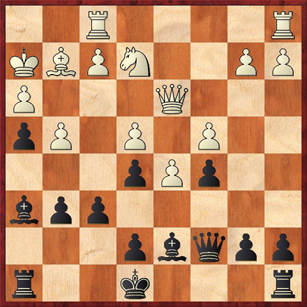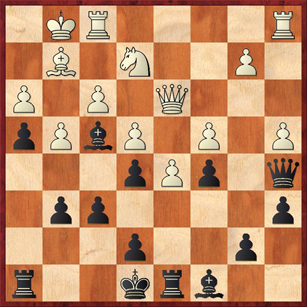Yesterday I played against Dan Burkhard in my second playoff game for the Santa Cruz Cup, and I lost again. This eliminates me from contention for first place, and ends my three-year winning streak. It feels like karma. Over the last three years I had lots of good breaks. But this year, I kept getting one great position after another and somehow finding ways to lose them.
I can’t say that the loss yesterday upset me too much — definitely not the way that my loss to Juande last week did (see A Visit From the Dementors). In fact, I was almost happy. It’s so rare for me to simply lose a chess game — almost all my losses either come because of terrible blunders that don’t teach me anything, or else they come wrapped up in the package of psychodrama known as time trouble (like my game with Juande). There’s always an excuse. But in the game with Dan, there were no ridiculous blunders, no psychodrama, and no excuses. I was way ahead on time, and I had a superior position. I just chose a bad plan. Which means that this is actually a game I can learn something from.
I’ll show you two positions from the game. The first is on my seventeenth move. I’m Black, and things are clearly going well for me. (Dan had missed some chances earlier in the game, but I’m going to skip that part.)
Here let’s try a Jesse Kraai-style evaluation of the position. What is the nature of Black’s advantage? The first thing that I would notice is the two bishops, and in particular the unopposed dark-squared bishop. This is clearly a long-term advantage for Black, assuming he can keep a diagonal open for that bishop. Second, I would notice White’s bad bishop, which has nothing to do. If Black could just trade off the heavy pieces and enter a minor-piece endgame, he would have very good chances to win. Third, I would notice the lineup of Black’s queen and White’s king on the same diagonal. This is a temporary situation, but it creates possibilities for tactics after 17. … f5, when the e-pawn cannot take on f5 because of 18. … e4+.
These are the good points for Black. What are the bad points? Let’s start with the undefended pawn on g6. If Black isn’t careful, White might be able to exploit that with a quick f2-f4, followed by e4-e5, blowing open the center and exposing Black’s king to Qd3xg6+. Second, Black’s rooks aren’t doing anything. They clearly need to be brought into the game. And third, Black needs to resolve the question of where his king should go. Should he castle queenside? Castle kingside? Stay in the center?
I chose the move 17. … Rd8, a poor choice on several counts. First, the king is not safe in the center, as long as that g6 pawn remains a target. Both Dan and I missed the idea of 18. f4 and 19. e5, which the computer recommends. But even if we don’t see that tricky tactic, there is another very important reason for castling, which is that Black needs to connect his rooks. It’s the last step of development, and it cannot be ignored. I was still too attached to the idea that I was somehow going to get a kingside attack with my rook on the h-file, but let’s face it. That file is securely blocked for the time being. That rook can do much better things on the f-file or the d-file or even the b-file.
I was reluctant to castle queenside, and I think rightly so. That would give White some attacking chances against my king. But why not castle kingside? Then I can bring both of my rooks over to the queenside, where I am essentially a piece up because White’s bishop can’t get there, and work on the pawn break … b5. So 17. … O-O would be a very good, sensible move.
Also, 17. … f5 needs to be considered very carefully. I finally decided not to play it because I didn’t see a good followup after 18. f3. If Black takes either pawn, then he is just opening the f-file for White. If Black pushes on to f4, he blocks his own bishop and negates the advantage of the two bishops. But what I failed to appreciate properly is that Black can just keep the tension –Â maintain the pawn on f5 and build his kingside attack. After 17. … f5 18. f3 O-O-O is now appropriate. Yes, it’s going to be double-edged, but I think that the interpolation of … f5 and f3 has improved Black’s prospects. He is basically guaranteed now that he can open up lines on the kingside whenever he wants, with … fg. He is now prepared to contest the f-file with … Rdf8. And a key point is that White was forced into the passive, defensive move f3, and thus has not been allowed to play his most dangerous pawn break, f2-f4.
So the bottom line is: for a safe and sound position, 17. … O-O was best. For a dynamic position with excellent attacking chances, 17. … f5 was best, followed by 18. … O-O-O. But just leaving the king in the center, uncastled, was a very foolish idea. Unfortunately, I am far too easily seduced by exotic ideas like this.
Let’s now move ahead five moves. The game continued 17. … Rd8?! 18. f3?! (better was f4!) 18. … a6 19. a4 Qa5 20. Nc3 Bf4+ 21. Kg1 Bc8 22. Ne2, arriving at this position.
Here I made a second very intriguing mistake. My thinking was: the whole idea of … Qa5 was to try to bring my queen to d2, and now White is letting me do it! Hip hip hooray! If 22. … Qd2 23. Qxd2 Bxd2, Black is getting closer to that superior endgame I mentioned before. If 22. … Qd2 23. Nxf4 Qxf4, Black has amazingly transferred his queen from a5 to f4 in just two moves, and now he can turn his attention back to the kingside attack. Woo hoo! What could possibly go wrong?
In my excitement I was completely blind to two features of the position, one subtle and one obvious. The obvious problem is that I have left my c-pawn unguarded, and moreover I have maneuvered my pieces into positions (rook on d8, bishop on c8) where they cannot protect it. Always think about unprotected pieces and pawns! As “notyetagm” says on www.chessgames.com, LPDO. (Loose Pieces Drop Off.)
The less obvious problem is that Black isn’t really ready to attack yet on the kingside. If I could just play … f5, take-take and sac on g4, I would be happy. I would even be glad to sacrifice the c5 pawn. But the trouble is that just as before, exchanging pawns on g4 only opens up the f-file, where the rook will be bearing down on Black’s queen — and after that, will imprison Black’s uncastled king! Now Black is really paying for all of the poor decisions made over the last few moves.
The startling conclusion is that Black’s queen on f4 is actually a completely useless piece! She isn’t able to do anything meaningful on the kingside, because she just becomes a target. And she isn’t able to get back over to the queenside to defend the c-pawn. Ironic, isn’t it, that after her mind-bogglingly quick trip from a5 to f4, she can’t get back?
So I played 22. … Qd2?, a very instructive mistake, and Dan correctly continued 23. Nxf4 Qxf4. Now he could have played 24. Qa3 right away, but he decided to play 24. a5 first. I remained oblivious to the danger, and played 24. … Qg3? This threatens 25. … Bxg4, but after Dan’s 25. Qa3! that threat was completely moot. The game ended quickly: 25. … f5 26. Qxc5 fg 27. fg Bxg4? (loses tactically, but on anything else Black is a pawn down and White has the compensation!) 28. Ra3! and Black can resign. (I actually played on for four more moves.)
Probably the best move for me would have been 22. … g5 =. I did not want to play this move because it basically ends any possibility of kingside attack. Also, after 23. Nxf4 gf the h-pawn is potentially weak. But I just had to be very honest and objective, and realize that Black no longer has an advantage in this position. If Black retreats the bishop, White is finally going to get to play f4, and will have counterplay.
All in all, this was an interesting game because it was entirely decided at a strategic level. The small burst of tactics at the end came only after the position was already lost. The strategic mistakes were very instructive, to me at least. My wife also was glad to hear that I had not beaten myself in my usual way, getting into time trouble and panicking, and she suggests that this is actually the first step toward solving my problems. I hope so. We’ll see. The downside is that losing can be habit-forming, so I would really like to break this slump.




